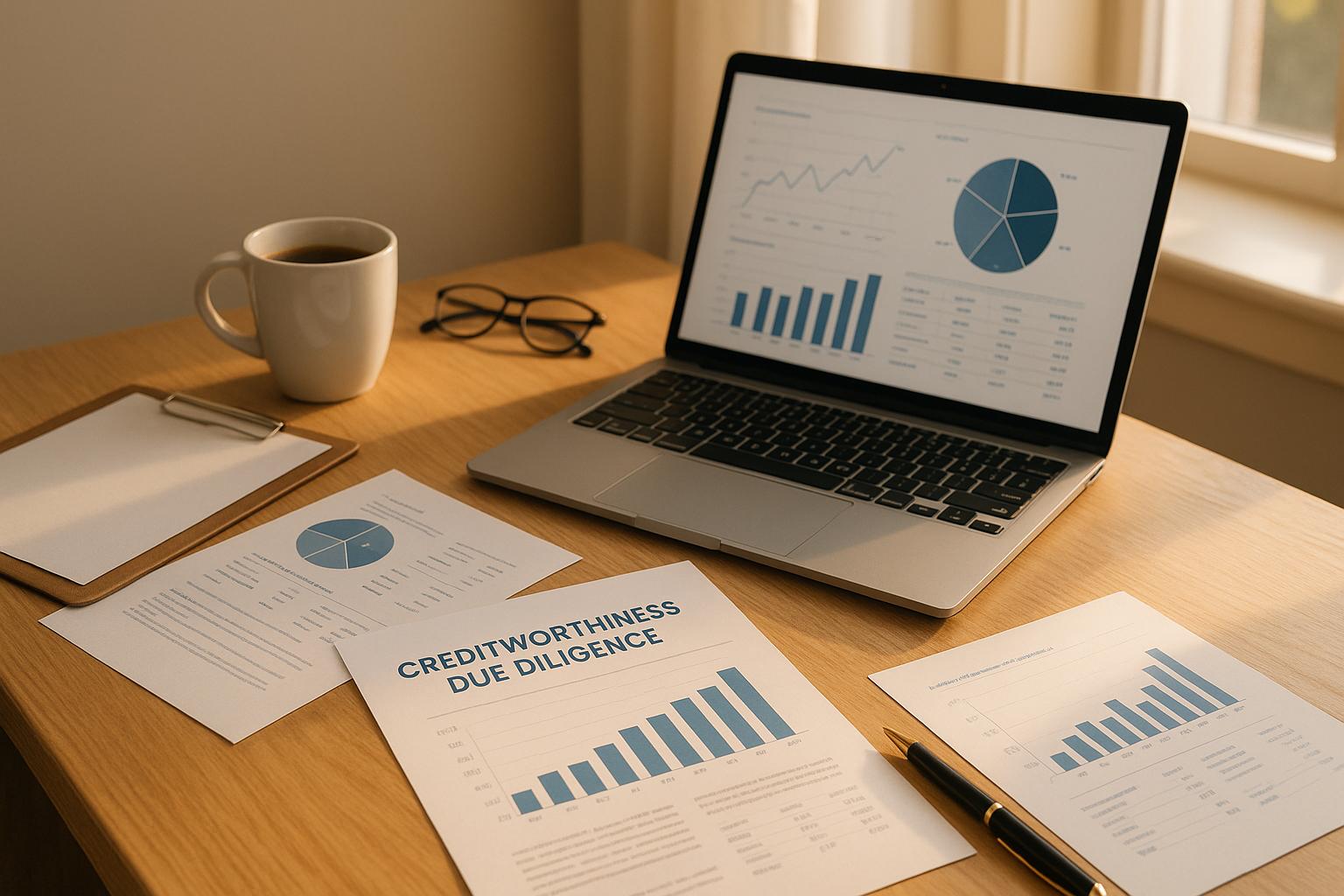Creditworthiness due diligence is the process of evaluating a borrower’s ability to repay debts. It involves analyzing financial data, verifying its accuracy, and assessing risks. This ensures lenders and debt buyers make informed decisions while staying compliant with regulations.
Platforms like Debexpert simplify due diligence by offering secure file sharing, portfolio analytics, and real-time communication. Combining these tools with a structured approach helps minimize risks and improve debt management outcomes.
When it comes to evaluating creditworthiness, a well-structured approach is essential. By following a systematic process, organizations can ensure accurate assessments while staying compliant with regulatory standards. This involves gathering and verifying data, as well as adhering to legal and privacy requirements.
The foundation of any effective due diligence process is comprehensive data collection. This step digs deeper than just pulling credit reports, incorporating a variety of sources to paint a full picture of a debtor's financial standing.
The goal here is to focus on data that directly impacts repayment ability. Once collected, the next step is to ensure the accuracy of this information.
Collecting data is just the beginning - verifying its accuracy is what ensures reliable assessments. Cross-referencing information with independent sources helps uncover discrepancies, outdated records, or potential fraud.
Thorough documentation of the verification process not only supports risk assessments but also creates an audit trail that meets regulatory requirements. Once data accuracy is confirmed, it’s equally important to handle this information responsibly.
Maintaining legal compliance during the due diligence process protects both the organization and the debtor. This includes obtaining proper consent and following strict privacy protocols.
Platforms like Debexpert simplify compliance by offering secure file sharing and real-time communication, allowing users to focus on analysis without worrying about regulatory pitfalls.
Once due diligence data has been gathered and verified, the next step is to systematically evaluate risk. This process transforms raw data into actionable insights, using structured methods that support consistent decision-making. A thorough risk evaluation not only sharpens credit assessments but also helps identify potential problems before they grow into larger issues.
Quantitative metrics rely on numbers and models to measure the likelihood of default and financial impact. These tools provide a clear, data-driven way to assess risk.
Numbers tell part of the story, but qualitative factors offer deeper insights into a borrower’s ability to adapt and thrive under changing conditions.
A well-structured framework combines both quantitative and qualitative insights to deliver reliable risk ratings.
Advanced analytics platforms can make this process more efficient. For instance, tools like Debexpert provide portfolio analytics that standardize risk evaluation, making it easier to assess large numbers of borrowers.
Additionally, a comprehensive framework should include escalation procedures for borderline cases or unusual scenarios. This ensures that complex situations are reviewed by senior analysts or committees. Such a systematic approach lays the groundwork for addressing legal and compliance challenges in managing debt portfolios.
Strengthening a debt portfolio goes beyond basic risk evaluation - it requires a solid approach to legal compliance and fraud prevention. These measures protect lenders and investors from regulatory missteps and financial losses due to fraud. Platforms like Debexpert play a key role by offering secure file sharing and maintaining detailed transaction records, which are essential for staying compliant.
Contract verification ensures that loan agreements are enforceable. This means checking that all contracts are complete, properly executed, and in line with both state and federal lending laws.
Licensing compliance involves confirming that all parties involved held valid licenses at the time of loan origination. Missing or expired licenses can create legal hurdles for debt collection and lower the portfolio's value.
Regulatory adherence is critical to avoid penalties. Compliance with laws like the FDCPA, TILA, and FCRA is non-negotiable, especially as the Consumer Financial Protection Bureau (CFPB) continues to ramp up enforcement efforts.
State-specific requirements add another layer of complexity. For instance, California’s debt collection regulations differ significantly from those in Texas or Florida. Some states require debt buyers to obtain additional licenses, while others mandate specific notifications when debt ownership changes hands. Knowing and addressing these variations is key to avoiding costly violations.
Fraud detection is another cornerstone of due diligence. Here’s how to tackle it effectively:
Once fraud risks are assessed, it’s time to plan for potential borrower defaults.
Preparing for defaults during the due diligence phase can save significant time and resources later. Here’s how to approach it:
These legal and fraud prevention measures are designed to strengthen the overall integrity of the portfolio. Tools like Debexpert’s audit trail features are particularly useful for maintaining a clear chain of custody, which is vital in debt collection litigation.
Technology has reshaped how lenders and investors evaluate creditworthiness, making the due diligence process faster, more accurate, and less prone to human error. Modern tools can process massive amounts of data in record time, revealing critical patterns that might otherwise go unnoticed. This shift to automated analysis and digital workflows has become essential for anyone looking to stay competitive in today’s fast-paced debt markets.
With access to verified data, technology takes due diligence a step further by offering real-time insights into portfolio performance. Advanced algorithms can flag irregularities across various data sources, while secure digital platforms ensure sensitive financial information remains protected. These advancements form the foundation for the sophisticated analytical tools discussed below.
Portfolio analytics software is now central to modern due diligence efforts. These tools dig deep into payment histories, identify seasonal trends, and even forecast future performance based on historical data. Machine learning algorithms enhance this process by uncovering risk factors that traditional methods might miss - like subtle shifts in payment timing or frequency, which could hint at financial trouble.
Automated data validation systems streamline the verification process by cross-referencing borrower information across multiple databases simultaneously. This eliminates the need to manually check employment records, income statements, or credit reports one by one. Real-time monitoring features add another layer of efficiency, enabling teams to keep a constant eye on portfolio performance and spot potential risks early.
Digital document management systems also play a crucial role. Using optical character recognition (OCR), these tools extract key details from scanned documents and automatically populate databases. This reduces repetitive manual work, supports compliance with regulations, and ensures thorough record-keeping.

Debexpert builds on these technological advancements to simplify and enhance the due diligence process. The platform provides robust portfolio analytics tools, offering clear data visualizations that showcase key metrics, payment behaviors, and risk indicators. This makes it easier for users to assess the strengths and weaknesses of debt portfolios.
To protect sensitive information, Debexpert employs secure file-sharing features, granting authorized parties controlled access to necessary documents. Its real-time communication tools allow buyers and sellers to discuss portfolio details, resolve documentation questions, and negotiate terms - all without jeopardizing data security.
Debexpert also offers flexible auction setups, supporting formats like English, Dutch, sealed-bid, and hybrid auctions. During the pre-auction phase, potential buyers can review masked portfolio details for preliminary analysis. Full documentation is then made available to qualified bidders, ensuring sensitive information remains protected while giving serious buyers the insights they need.
With both mobile and desktop access, Debexpert ensures that due diligence teams can review data and communicate with stakeholders anytime, anywhere - an invaluable feature for managing time-sensitive deals.
Additionally, the platform offers notifications for preferred debt types, alerting buyers when portfolios that match their investment criteria become available. This targeted approach helps investors focus their efforts on the most relevant opportunities, improving the efficiency and security of the entire due diligence process described earlier.
Effective creditworthiness due diligence calls for a structured approach that combines detailed data collection, meticulous verification, and the strategic use of technology. Research shows that a one-unit rise in the FinTech index correlates with a reduction of non-performing loans by 0.458 units. This highlights how adopting advanced technologies can significantly enhance risk management efforts.
Many leading organizations now use AI-powered platforms to automate processes, improve data analysis, and identify risks more efficiently.
Modern systems go beyond the initial evaluation by offering real-time monitoring. Continuous oversight allows organizations to detect emerging risks early, enabling proactive risk management rather than reactive responses.
In today’s fast-changing debt trading environment, combining human expertise with cutting-edge technology is no longer optional - it’s essential. Big data tools and the integration of diverse data sources now allow for dynamic risk management, shifting from static assessments to continuous monitoring and proactive threat mitigation.
Platforms like Debexpert illustrate how technology can elevate the due diligence process. Features such as secure file sharing, portfolio analytics, and real-time communication offer the tools needed for efficient, compliant evaluations.
The key to mastering creditworthiness due diligence lies in finding the right balance between thoroughness and efficiency. By pairing detailed data verification and strong compliance measures with advanced technology, investors can not only reduce risks but also uncover the best opportunities in today’s competitive debt markets.
Technology plays a key role in improving the creditworthiness due diligence process by simplifying how data is collected, analyzed, and assessed for risk. Automated tools cut down on manual work and minimize errors, making evaluations quicker and more dependable.
With advanced tools like artificial intelligence (AI), machine learning, and predictive analytics, it's possible to gain a deeper understanding of debtor credit profiles. These technologies help pinpoint potential risks, predict repayment patterns, and enhance decision-making, leading to a more comprehensive and efficient evaluation process.
Lenders can meet privacy law requirements during creditworthiness assessments by following federal regulations like the Fair Credit Reporting Act (FCRA). This law ensures that consumer credit data is accessed strictly for legitimate purposes. Lenders must also verify they have a valid reason - such as obtaining borrower consent - before pulling credit reports.
In addition, compliance with the Gramm-Leach-Bliley Act is crucial. This law mandates the protection of personal financial information, emphasizing the need for secure handling of sensitive data. Regularly updating compliance policies and providing employees with training on privacy standards can help reduce legal risks and enhance data security. Keeping up with changes in regulations is key to maintaining compliance over time.
When assessing someone's creditworthiness, it’s important to consider both quantitative and qualitative factors.
On the quantitative side, numbers tell the story. Metrics like the debt-to-income ratio, cash flow analysis, and liquidity levels offer clear, measurable data about whether a borrower can handle their financial responsibilities.
Qualitative factors, on the other hand, dig into the less tangible aspects. This includes evaluating the borrower's management skills, professional reputation, and the overall stability of their business. These insights come from analyzing leadership abilities, industry reputation, and a track record of reliability.
Looking at both types of factors together provides a well-rounded view of risk, making the due diligence process more thorough and informed.
